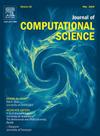New globally Lipschitz no-equilibrium fractional order systems and control of hidden memory chaotic attractors
IF 3.1
3区 计算机科学
Q2 COMPUTER SCIENCE, INTERDISCIPLINARY APPLICATIONS
引用次数: 0
Abstract
In continuous-time no-equilibrium nonlinear fractional order systems, bounded attractors are often termed as hidden memory attractors that can provide very complicated dynamics, and their localization seems crucial. In many engineering applications of interest, a famous problem deals with the identification of globally Lipschitz no-equilibrium nonlinear fractional order systems that can produce hidden memory chaotic attractors that remain unknown. We address two new no-equilibrium 3-state variables nonlinear fractional order systems; one is non-autonomous and another is autonomous, where both systems nonlinearity satisfy the global Lipschitz condition. It has been discovered that such a non-autonomous system gives rise to a globally Lipschitz hidden memory chaotic attractor when system orders , also when . The autonomous system produces a globally Lipschitz hidden memory chaotic attractor when system orders become , , as well as , , . In many applications of interest, it is often needed to have globally Lipschitz hidden memory chaotic attractors and reference control goal dynamics that seem crucial to widen the use of important nonlinear systems. We introduce a novel control strategy to address controlling hidden memory chaotic attractors found in such systems that seem impossible to control in many control design problems. Numerical simulations, including theoretical analysis, illustrate the effectiveness of the proposed control method.
新的全局Lipschitz非平衡分数阶系统及隐藏记忆混沌吸引子控制
在连续时间非平衡非线性分数阶系统中,有界吸引子通常被称为隐藏记忆吸引子,它可以提供非常复杂的动力学,其定位似乎至关重要。在许多感兴趣的工程应用中,一个著名的问题涉及全局Lipschitz非平衡非线性分数阶系统的识别,该系统可以产生未知的隐藏记忆混沌吸引子。研究了两个新的非平衡三状态变量非线性分数阶系统;一类是非自治的,另一类是自治的,这两个系统的非线性都满足全局Lipschitz条件。发现当系统阶数δ1=0.998,δ2=0.997,δ3=0.999, δ1=0.999,δ2=0.999,δ3=0.999时,非自治系统产生全局Lipschitz隐记忆混沌吸引子。当系统阶数为δ1=0.997、δ2=0.998、δ3=0.999以及δ1=0.997、δ2=0.997、δ3=0.997时,自治系统产生全局Lipschitz隐记忆混沌吸引子。在许多感兴趣的应用中,通常需要全局Lipschitz隐藏记忆混沌吸引子和参考控制目标动力学,这对于扩大重要非线性系统的应用似乎至关重要。我们引入了一种新的控制策略来解决在许多控制设计问题中似乎无法控制的系统中发现的隐藏记忆混沌吸引子的控制问题。数值仿真和理论分析验证了所提控制方法的有效性。
本文章由计算机程序翻译,如有差异,请以英文原文为准。
求助全文
约1分钟内获得全文
求助全文
来源期刊

Journal of Computational Science
COMPUTER SCIENCE, INTERDISCIPLINARY APPLICATIONS-COMPUTER SCIENCE, THEORY & METHODS
CiteScore
5.50
自引率
3.00%
发文量
227
审稿时长
41 days
期刊介绍:
Computational Science is a rapidly growing multi- and interdisciplinary field that uses advanced computing and data analysis to understand and solve complex problems. It has reached a level of predictive capability that now firmly complements the traditional pillars of experimentation and theory.
The recent advances in experimental techniques such as detectors, on-line sensor networks and high-resolution imaging techniques, have opened up new windows into physical and biological processes at many levels of detail. The resulting data explosion allows for detailed data driven modeling and simulation.
This new discipline in science combines computational thinking, modern computational methods, devices and collateral technologies to address problems far beyond the scope of traditional numerical methods.
Computational science typically unifies three distinct elements:
• Modeling, Algorithms and Simulations (e.g. numerical and non-numerical, discrete and continuous);
• Software developed to solve science (e.g., biological, physical, and social), engineering, medicine, and humanities problems;
• Computer and information science that develops and optimizes the advanced system hardware, software, networking, and data management components (e.g. problem solving environments).
 求助内容:
求助内容: 应助结果提醒方式:
应助结果提醒方式:


